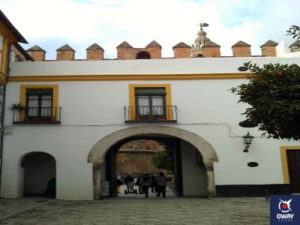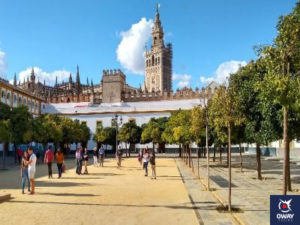This is one of the places you should not miss when you make a trip to Seville. It is a historic place, it was the old parade ground of the Alcázar, and nowadays it is part of the Royal Alcazar of Seville. This emblematic square belongs to the neighbourhood of La Cruz. Its name comes from the old tradition of hanging flags in this place when a king came to visit the city of Seville.
History of the Patio de las Banderas
The beginnings of the construction of this square date back to the presence of the Muslims in Seville, when King Abderramán III ordered the construction of a palace in this space and it was known as Dar Al-lmara, the Prince’s house or Governor’s house, back in the 10th century. However, it was Philip V who put it to use as an armoury in the mid-18th century. A long time later, in 1816, benches and a fountain were installed in the centre, and the entire space was surrounded by a grove of trees. The benches, however, were removed in 1857 and the trees were later replaced by orange trees.
For a time this square was known as the Plaza Grande, and rightly so, since it is of large dimensions, although as we have already mentioned, its name is due to the flags that were painted on the wall gate that was in the Plaza del Triunfo and through which the courtyard could be accessed directly.
Considering that the patio de las Banderas was an enclosed area that was easy to defend, houses were built on either side of it. House number 2 is particularly relevant because it has an Almohad vault and a garden.

What to do in the Patio de las Banderas
On the occasion of the Ibero-American Exhibition in Seville in 1929, the central part, where there was a fountain that had been completely destroyed, was remodelled once again. A new fountain was installed, adding a new paved area around it and also making it possible for vehicles to circulate around it. During your visit to the Patio de las Banderas you can admire its central fountain, walking through the grove of orange trees that surround it. You will also see that this courtyard is surrounded by a series of houses in which many famous people have lived, such as the writer Fernán Caballero and the painter Joaquín Domínguez Bécquer. In addition, from the Patio de Banderas in Seville you can admire views of Seville’s Cathedral and the spectacular Giralda.

Admire the famous altarpiece
You can feast your eyes on the inside of the entrance arch, where there is an altarpiece with the Virgin of the Conception, Saint Peter, Saint Ferdinand, Saint Joachim, Saint Anne and Saint Joseph with the Child Jesus in his arms. Near the exit of the halt, there is a wall where you can see the remains of the Jardín del Yeso, an example of Almohad art.
Discover the remains of the Al-Mutamid Palace
It is also possible to see the exterior of the houses located in this courtyard, some of which contain the remains of the Al Mutamid Palace and which have recently been acquired by the Seville City Council to become a new attraction in the Real Alcázar. These are the houses in which we have previously mentioned that famous people lived.ç
How to get there
The address of this place is the Plaza del Patio de Banderas, post code 41004.
In the vicinity of the Patio, it is possible to access the Real Alcázar of Seville. Also very close, a few minutes walk away, it is possible to see the Patio de Doncellas or the Puerta de Jerez. It is also advisable to wander through the streets of the Jewish Quarter and find other attractions in Seville. Although you can walk, you can also use public transport if you are further away. By bus you can get there with the following lines 03, 05, 21, EA, M-140, M-152, M-153, by train on line C1, by metro L1 and finally by light rail T1.
Curiosities
- Another person who has lived here throughout history was the painter Valeriano Bécquer.
- The current appearance of Seville’s Patio de Banderas is not the original and dates back to the years prior to the Ibero-American Exhibition of 1929.
- Like all magical corners, this courtyard also has its own legend, the one that says that at night you can feel the footsteps of someone unseen, that someone being King D. Pedro.
- The exit through the Callejón de la Judería ends at the Arco de Las Cadenas and leads to Calle Vida, one of the most famous streets in the Barrio de Santa Cruz.
- It also used to be a horse riding school as it was so close to the halt, nowadays the exit door to the Alcázar.

To complete your visit to the city, enjoy our best guided tours in Seville:

